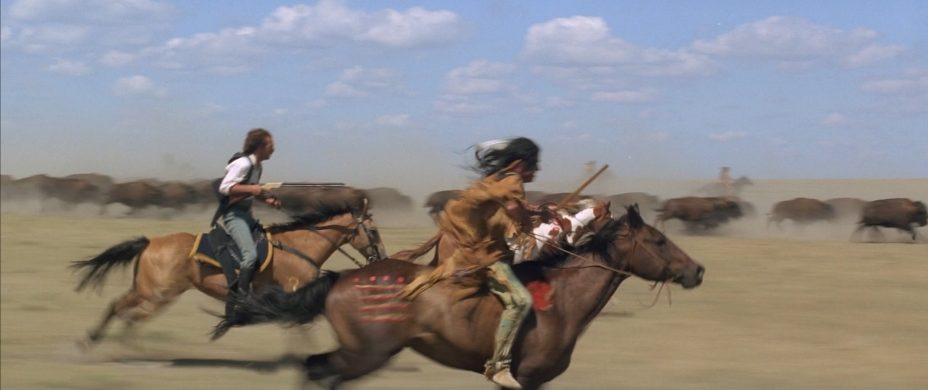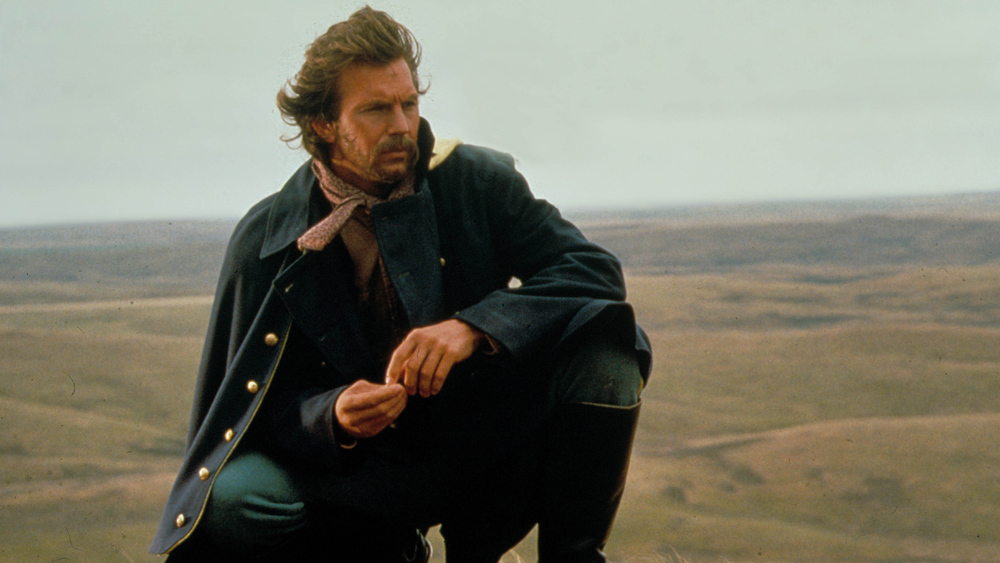Dances With Wolves (1990)
CAST: Kevin Costner, Mary McDonnell, Graham Greene, Rodney A. Grant, Tantoo Cardinal, Floyd Red Crow Westerman, Robert Pastorelli, Maury Chaykin, Charles Rocket, Wes Studi
REVIEW:
With Dances With Wolves, not only did actor Kevin Costner make an impressive directorial debut (arguably one of the most accomplished, and the most ambitious and big-scale achievements by a novice director in cinematic history), he also virtually singlehandedly breathed new life into the Western genre. Once enormously popular, Westerns had been few and far between apart from 1985’s Silverado and Quigley Down Under only a month before Costner’s magnum opus, and both of those installments were far more conventional and stereotypical than what Costner has made here (Dances With Wolves could be considered a “revisionist Western” and isn’t interested in shoot-em-ups or stereotypical Cowboys vs. Indians action). But Dances With Wolves isn’t just a Western (of sorts) or an attention-catching directorial debut, it’s a great, epic motion picture that transports the viewer immersively into its world and keeps them there for over three hours.
For Union Lieutenant John J. Dunbar (Kevin Costner), his life takes a strange turn by virtue of his trying to end it, when on a Civil War battlefield, he makes what’s intended as a suicide charge on horseback on a dug-in Confederate position rather than face the prospect of losing his injured leg to amputation. Miraculously, Dunbar not only survives, but inadvertently provides a diversion that enables a Union victory, rewarded with keeping his leg (the witnessing General contributes his personal surgeon), a promotion, and being assigned wherever he wants. Dunbar chooses the frontier, striking out for a remote outpost on the great open prairie far to the West from the ongoing war. The assignment has an inauspicious beginning; despite his awe for the wild frontier, Dunbar finds the fort abandoned and rundown. Nonetheless, the stoic officer digs in with a stiff upper lip awaiting reinforcements, even as he slowly loses hope for their arrival, his only companionship provided by his trusty horse Cisco and an inquisitive wolf he nicknames Two Socks…until one day a chance encounter brings him into contact with the Sioux, a meeting that will change both of their worlds. Initially, the Sioux, principally the thoughtful medicine man Kicking Bird (Graham Greene) and tempestuous young warrior Wind In His Hair (Rodney A. Grant), aren’t sure what to do about Dunbar, and mistrust and tension runs high, but as they have more tentative encounters and gradually learn to communicate, they form a truce, then a bond, especially when Stands With a Fist (Mary McDonnell), an orphaned white woman adopted by the tribe, is appointed to act as interpreter. And the more he becomes immersed in the Sioux way of life, the more infatuated Dunbar becomes with it (and Stands With a Fist herself). After a series of bonding moments, including being invited to take part in a great buffalo hunt, Dunbar becomes fully embraced by the tribe….until one day, the war finally comes home when the long-delayed army reinforcements arrive at the fort and don’t look kindly on what they find.
 Dances With Wolves works on multiple levels as a rousing adventure, a stirring drama, a love story, and an ode to a bygone world and way of life. Costner goes out of his way to forego and in fact actively deconstruct and subvert old-fashioned black-and-white Cowboys vs. Indians stereotypes with respectful and sympathetic depictions of the Sioux, and strove for authenticity, using a real full-blooded wolf rather than a half-breed for Two Socks, casting only authentically Native American actors (albeit from a variety of tribes) in the roles of the Sioux (and their lesser-seen enemies, the Pawnee), and having the Sioux speak their own language, Lakota, with subtitles. And not only are the principal Sioux distinct characters with individual personalities rather than an assortment of caricatures, so too are the army men who arrive in the climax, portrayed not so much evil as callous and ignorant (Charles Rocket’s Lieutenant Elgin in particular is portrayed at least somewhat sympathetically, but surrounded by some unsavory compatriots). There’s no real major “villain”; a brutal Pawnee war chief (Wes Studi), and the soldiers who eventually arrive on the scene both serve briefly as antagonists at different points of the movie, but they both have small roles. Reportedly, Costner had to do a lot of fighting back against studio pressure to get his way with some of this, especially the movie’s formidable runtime and having significant chunks of the movie in another language with subtitles, ultimately serving as producer as well as star and director and chipping in a sizable chunk of his own money to get the film made. Costner should be respected for fighting for his own vision and for the right to unfold his story at its own pace; too much rushed storytelling or concessions would have diluted the overall experience.
Dances With Wolves works on multiple levels as a rousing adventure, a stirring drama, a love story, and an ode to a bygone world and way of life. Costner goes out of his way to forego and in fact actively deconstruct and subvert old-fashioned black-and-white Cowboys vs. Indians stereotypes with respectful and sympathetic depictions of the Sioux, and strove for authenticity, using a real full-blooded wolf rather than a half-breed for Two Socks, casting only authentically Native American actors (albeit from a variety of tribes) in the roles of the Sioux (and their lesser-seen enemies, the Pawnee), and having the Sioux speak their own language, Lakota, with subtitles. And not only are the principal Sioux distinct characters with individual personalities rather than an assortment of caricatures, so too are the army men who arrive in the climax, portrayed not so much evil as callous and ignorant (Charles Rocket’s Lieutenant Elgin in particular is portrayed at least somewhat sympathetically, but surrounded by some unsavory compatriots). There’s no real major “villain”; a brutal Pawnee war chief (Wes Studi), and the soldiers who eventually arrive on the scene both serve briefly as antagonists at different points of the movie, but they both have small roles. Reportedly, Costner had to do a lot of fighting back against studio pressure to get his way with some of this, especially the movie’s formidable runtime and having significant chunks of the movie in another language with subtitles, ultimately serving as producer as well as star and director and chipping in a sizable chunk of his own money to get the film made. Costner should be respected for fighting for his own vision and for the right to unfold his story at its own pace; too much rushed storytelling or concessions would have diluted the overall experience.
Though Dances With Wolves is intentionally slow-moving and the bursts of action are few and far between, there are several well-executed battle sequences (the opening Civil War battlefield, a later Pawnee raid on the Sioux village, and the climactic clash between the Sioux and the soldiers) and Costner doesn’t shy away from graphic violence. By far the most extensive and ambitious action-oriented sequence, and in fact the centerpiece sequence of the movie, is the buffalo hunt, in which Dunbar rides on horseback side-by-side with the Sioux warriors alongside a stampede of thousands of buffalo and brings down several of them. It’s a thunderously exciting, adrenaline-generating sequence, and the adeptness with which Costner choreographs the action on an epic scale demonstrates perhaps the most incontrovertibly of any moment in the movie how impressive of an accomplishment this was for him as an inexperienced filmmaker. Costner’s production company spent $250,000 on animatronic buffalo for this sequence; no real buffalo were harmed, but the blend of the real thing and the animatronics is indistinguishable. Dean Semler’s cinematography is suitably sweeping, complimented perfectly by John Barry’s epic, grandiose score.
The biggest stumbling block for some is Dances With Wolves‘ runtime; it runs a formidable three hours, expanded to a whopping nearly four hours if one views the “special edition” of footage cut from the initial theatrical release (the extended edition adds in mostly small bits and pieces here and there that, while adding a smidgen more development of some plot points, is not substantially different besides padding out the runtime). It’s hard to deny that the movie runs at least a little too long; some superfluous or dragged-out scenes here and there could have trimmed to tighten up a leisurely, slow-moving pace. But at the same time, trimming the movie down too much (as the studio wanted) would have been a mistake. The leisurely slow burn accentuates the immersion in the world unfolding onscreen and later developments would not have their effect if the movie had not taken the time to ensure that Dunbar’s character and his gradually deepening relationship with the Sioux was as well-established as it is.
While Kevin Costner is not generally regarded as an especially accomplished thespian, and his work behind the camera will likely be considered more impressive than his work in front of it, he’s fine as Dunbar, especially considering a significant chunk of the screentime, particularly early on, consists of virtually a one-man show before the Sioux make their entrance. It’s not a particularly dynamic performance, but Costner’s laid-back presence imbues Dunbar with an effective everyman persona that works as initially a passive observer who gives us an entry point into the great plains. In a sense, Dunbar is almost an audience surrogate; we’re experiencing this new world at the same rate as him, discovering it as he does. The supporting cast is low-profile and not stocked with any “stars” or particularly familiar faces. Among the Sioux, Rodney A. Grant as the fiery Wind In His Hair is a forceful and distinctive presence, with Graham Greene’s mild-tempered, thoughtful Kicking Bird as his more subdued counterpart. Mary McDonnell gives a convincing portrayal of a white woman raised by the Sioux and brushing up on her own rusty English to serve as Dunbar’s interpreter, as well as providing an effective counterpart in her eventual romance with Dunbar. In keeping with its sense of un-Hollywoodized realism, Stands With A Fist is a mature woman with weathered features, not a “sexy” love interest (McDonnell is three years older than Costner, a rare thing in a film industry that is often loathe to cast less youthful female love interests, even for middle-aged leading men). In small roles, Robert Pastorelli provides a trifling of comic relief as Dunbar’s slovenly guide to the fort, and character actor Maury Chaykin has an eccentric opening bit part as an alcoholic, mentally unstable officer who dispatches Dunbar on his assignment.
Will Kevin Costner ever direct again? It remains to be seen, and it’s perhaps even more in question whether another project could equal the scale and ambition (and success) of this one, but whether or not he ever ventures behind the camera again, he can be proud of his singular accomplishment here. Dances With Wolves is a cinematic landmark, not merely a great debut for a novice director, but a great film period, and regardless of what else Costner ever does in his career, it will stand the test of time as such.
* * * *
